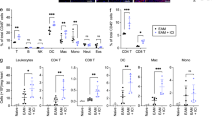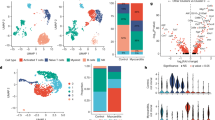Abstract
Myocarditis is a principal cause of heart disease among young adults and is often a precursor of heart failure due to dilated cardiomyopathy. We show here that complement is critical for the induction of experimental autoimmune myocarditis and that it acts through complement receptor type 1 (CR1) and type 2 (CR2). We also found a subset of CD44hiCD62Llo T cells that expresses CR1 and CR2 and propose that both receptors are involved in the expression of B and T cell activation markers, T cell proliferation and cytokine production. These findings provide a mechanism by which activated complement, a key product of the innate immune response, modulates the induction of an autoimmune disease.
This is a preview of subscription content, access via your institution
Access options
Subscribe to this journal
Receive 12 print issues and online access
$209.00 per year
only $17.42 per issue
Buy this article
- Purchase on Springer Link
- Instant access to full article PDF
Prices may be subject to local taxes which are calculated during checkout







Similar content being viewed by others
References
Fearon, D. T. & Carroll, M. C. Regulation of B lymphocyte responses to foreign and self-antigens by the CD19/CD21 complex. Annu. Rev. Immunol. 18, 393–422 (2000).
Carroll, M. C. The role of complement and complement receptors in induction and regulation of immunity. Annu. Rev. Immunol. 16, 545–568 (1998).
Kinoshita, T. et al. Monoclonal antibodies to mouse complement receptor type 1 (CR1). Their use in a distribution study showing that mouse erythrocytes and platelets are CR1-negative. J. Immunol. 140, 3066–3072 (1988).
Hebell, T., Ahearn, J. M. & Fearon, D. T. Suppression of the immune response by a soluble complement receptor of B lymphocytes. Science 254, 102–105 (1991).
Molina, H. et al. Markedly impaired humoral immune response in mice deficient in complement receptors 1 and 2. Proc. Natl Acad. Sci. USA 93, 3357–3361 (1996).
Dempsey, P. W., Allison, M. E., Akkaraju, S., Goodnow, C. C. & Fearon, D. T. C3d of complement as a molecular adjuvant: bridging innate and acquired immunity. Science 271, 348–350 (1996).
Fang, Y., Xu, C., Fu, Y. X., Holers, V. M. & Molina, H. Expression of complement receptors 1 and 2 on follicular dendritic cells is necessary for the generation of a strong antigen-specific IgG response. J. Immunol. 160, 5273–5279 (1998).
Pepys, M. B. Role of complement in induction of antibody production in vivo. Effect of cobra factor and other C3-reactive agents on thymus-dependent and thymus-independent antibody responses. J. Exp. Med. 140, 126–145 (1974).
Wolfgram, L. J., Beisel, K. W., Herskowitz, A. & Rose, N. R. Variations in the susceptibility to Coxsackievirus B3-induced myocarditis among different strains of mice. J. Immunol. 136, 1846–1852 (1986).
Neu, N. et al. Cardiac myosin induces myocarditis in genetically predisposed mice. J. Immunol. 139, 3630–3636 (1987).
Neu, N., Beisel, K. W., Traystman, M. D., Rose, N. R. & Craig, S. W. Autoantibodies specific for the cardiac myosin isoform are found in mice susceptible to Coxsackievirus B3-induced myocarditis. J. Immunol. 138, 2488–2492 (1987).
Lodge, P. A., Herzum, M., Olszewski, J. & Huber, S. A. Coxsackievirus B-3 myocarditis. Acute and chronic forms of the disease caused by different immunopathogenic mechanisms. Am. J. Pathol. 128, 455–463 (1987).
Estrin, M. & Huber, S. A. Coxsackievirus B3-induced myocarditis. Autoimmunity is L3T4+ T helper cell and IL-2 independent in BALB/c mice. Am. J. Pathol. 127, 335–341 (1987).
Smith, S. C. & Allen, P. M. Myosin-induced acute myocarditis is a T cell-mediated disease. J. Immunol. 147, 2141–2147 (1991).
Wolfgram, L. J., Beisel, K. W. & Rose, N. R. Heart-specific autoantibodies following murine coxsackievirus B3 myocarditis. J. Exp. Med. 161, 1112–1121 (1985).
Liao, L. et al. Antibody-mediated autoimmune myocarditis depends on genetically determined target organ sensitivity. J. Exp. Med. 181, 1123–1131 (1995).
Huber, S. A. & Lodge, P. A. Coxsackievirus B-3 myocarditis. Identification of different pathogenic mechanisms in DBA/2 and Balb/c mice. Am. J. Pathol. 122, 284–291 (1986).
Kuan, A. P., Zuckier, L., Liao, L., Factor, S. M. & Diamond, B. Immunoglobulin isotype determines pathogenicity in antibody-mediated myocarditis in naive mice. Circ. Res. 86, 281–285 (2000).
Karp, C. L. et al. Identification of complement factor 5 as a susceptibility locus for experimental allergic asthma. Nature Immunol. 1, 221–226 (2000).
Erickson, R. P., Tachibana, D. K., Herzenberg, L. A. & Rosenberg, L. T. A single gene controlling hemolytic complement and a serum antigen in the mouse. J. Immunol. 92, 611–615 (1964).
Davoust, N. et al. Central nervous system-targeted expression of the complement inhibitor sCrry prevents experimental allergic encephalomyelitis. J. Immunol. 163, 6551–6556 (1999).
Morgan, B. P. & Walport, M. J. Complement deficiency and disease. Immunol. Today 12, 301–306 (1991).
Colten, H. R. & Rosen, F. S. Complement deficiencies. Annu. Rev. Immunol. 10, 809–834 (1992).
Wang, Y., Rollins, S. A., Madri, J. A. & Matis, L. A. Anti-C5 monoclonal antibody therapy prevents collagen-induced arthritis and ameliorates established disease. Proc. Natl Acad. Sci. USA 92, 8955–8959 (1995).
Malkiel, S., Kuan, A. P. & Diamond, B. Autoimmunity in heart disease: mechanisms and genetic susceptibility. Mol. Med. Today 2, 336–342 (1996).
Huber, S. A., Job, L. P. & Woodruff, J. F. Lysis of infected myofibers by coxsackievirus B-3-immune T lymphocytes. Am. J. Pathol. 98, 681–694 (1980).
Afanasyeva, M. et al. Experimental autoimmune myocarditis in A/J mice is an IL-4 dependent disease with a Th2 phenotype. Am. J. Pathol. 159, 193–203 (2001).
Lane, J. R., Neumann, D. A., Lafond-Walker, A., Herskowitz, A. & Rose, N. R. Interleukin 1 or tumor necrosis factor can promote Coxsackie B3-induced myocarditis in resistant B10.A mice. J. Exp. Med. 175, 1123–1129 (1992).
Lane, J. R., Neumann, D. A., Lafond-Walker, A., Herskowitz, A. & Rose, N. R. Role of IL-1 and tumor necrosis factor in coxsackie virus-induced autoimmune myocarditis. J. Immunol. 151, 1682–1690 (1993).
Wang, Y., Afanasyeva, M., Hill, S. L. & Rose, N. R. Characterization of murine autoimmune myocarditis induced by self and foreign cardiac myosin. Autoimmunity 31, 151–162 (1999).
Neumann, D. A., Lane, J. R., Allen, G. S., Herskowitz, A. & Rose, N. R. Viral myocarditis leading to cardiomyopathy: do cytokines contribute to pathogenesis? Clin. Immunol. Immunopathol. 68, 181–190 (1993).
Pummerer, C., Berger, P., Fruhwirth, M., Ofner, C. & Neu, N. Cellular infiltrate, major histocompatibility antigen expression and immunopathogenic mechanisms in cardiac myosin-induced myocarditis. Lab. Invest. 65, 538–547 (1991).
Smith, S. C. & Allen, P. M. Expression of myosin-class II major histocompatibility complexes in the normal myocardium occurs before induction of autoimmune myocarditis. Proc. Natl Acad. Sci. USA 89, 9131–9135 (1992).
Wang, Y. C. et al. Influence of cytokines and immunosuppressive drugs on major histocompatibility complex class I/II expression by human cardiac myocytes in vitro. Hum. Immunol. 31, 123–133 (1991).
Carter, R. H. & Fearon, D. T. CD19: lowering the threshold for antigen receptor stimulation of B lymphocytes. Science 256, 105–107 (1992).
Fischer, M. B. et al. Dependence of germinal center B cells on expression of CD21/CD35 for survival. Science 280, 582–585 (1998).
Baiu, D. C. et al. Modulation of the humoral immune response by antibody-mediated antigen targeting to complement receptors and Fc receptors. J. Immunol. 162, 3125–3130 (1999).
Newman, S. L., Devery-Pocius, J. E., Ross, G. D. & Henson, P. M. Phagocytosis by human monocyte-derived macrophages. Independent function of receptors for C3b (CR1) and iC3b (CR3). Complement 1, 213–227 (1984).
Kerekes, K., Prechl, J., Bajtay, Z., Jozsi, M. & Erdei, A. A further link between innate and adaptive immunity: C3 deposition on antigen-presenting cells enhances the proliferation of antigen-specific T cells. Int. Immunol. 10, 1923–1930 (1998).
Delibrias, C. C., Fischer, E., Bismuth, G. & Kazatchkine, M. D. Expression, molecular association, and functions of C3 complement receptors CR1 (CD35) and CR2 (CD21) on the human T cell line HPB-ALL. J. Immunol. 149, 768–774 (1992).
Fischer, E., Delibrias, C. & Kazatchkine, M. D. Expression of CR2 (the C3dg/EBV receptor, CD21) on normal human peripheral blood T lymphocytes. J. Immunol. 146, 865–869 (1991).
Delibrias, C. C., Mouhoub, A., Fischer, E. & Kazatchkine, M. D. CR1(CD35) and CR2(CD21) complement C3 receptors are expressed on normal human thymocytes and mediate infection of thymocytes with opsonized human immunodeficiency virus. Eur. J. Immunol. 24, 2784–2788 (1994).
Moir, S. et al. B cells of HIV-1-infected patients bind virions through CD21-complement interactions and transmit infectious virus to activated T cells. J. Exp. Med. 192, 637–646 (2000).
Kacani, L. et al. Detachment of human immunodeficiency virus type 1 from germinal centers by blocking complement receptor type 2. J. Virol. 74, 7997–8002 (2000).
Brooimans, R. A., van der Ark, A. A., Buurman, W. A., van Es, L. A. & Daha, M. R. Differential regulation of complement factor H and C3 production in human umbilical vein endothelial cells by IFN-γ and IL-1. J. Immunol. 144, 3835–3840 (1990).
Terui, T. et al. C3 production of cultured human epidermal keratinocytes is enhanced by IFNγ and TNFα through different pathways. J. Invest Dermatol. 108, 62–67 (1997).
Shiverick, K. T., Thomas, L. L. & Alpert, N. R. Purification of cardiac myosin. Application to hypertrophied myocardium. Biochim. Biophys. Acta 393, 124–133 (1975).
Kinoshita, T. et al. Characterization of murine complement receptor type 2 and its immunological cross-reactivity with type 1 receptor. Int. Immunol. 2, 651–659 (1990).
Wiersma, E. J., Kinoshita, T. & Heyman, B. Inhibition of immunological memory and T-independent humoral responses by monoclonal antibodies specific for murine complement receptors. Eur. J. Immunol. 21, 2501–2506 (1991).
Wang, Y., Afanasyeva, M., Hill, S. L., Kaya, Z. & Rose, N. R. Nasal administration of cardiac myosin suppresses autoimmune myocarditis in mice. J. Am. Coll. Cardiol. 36, 1992–1999 (2000).
Acknowledgements
We thank P. Caturegli, E. A. Stafford, M. V. Talor, W. M. Baldwin III, S. Mirshahidi and C. L. Burek for critically reading the manuscript and for technical advice. Supported by NIH grants ES07141, HL33878, HL65100 (to N. R. R.) and AI31105 (to V. M. H.). Z. K. was supported by the Deutsche Herzstiftung. T. T. was supported by the Deutsche Forschungsgemeinschaft.
Author information
Authors and Affiliations
Corresponding author
Rights and permissions
About this article
Cite this article
Kaya, Z., Afanasyeva, M., Wang, Y. et al. Contribution of the innate immune system to autoimmune myocarditis: a role for complement. Nat Immunol 2, 739–745 (2001). https://doi.org/10.1038/90686
Received:
Accepted:
Issue Date:
DOI: https://doi.org/10.1038/90686
This article is cited by
-
Role of High Mobility Group Box 1 in Cardiovascular Diseases
Inflammation (2022)
-
Novel mechanisms and functions of complement
Nature Immunology (2017)
-
Expanding the therapeutic options for renal involvement in lupus: eculizumab, available evidence
Rheumatology International (2017)
-
Cacao polyphenols ameliorate autoimmune myocarditis in mice
Hypertension Research (2016)
-
Low-dose mercury heightens early innate response to coxsackievirus infection in female mice
Inflammation Research (2015)



